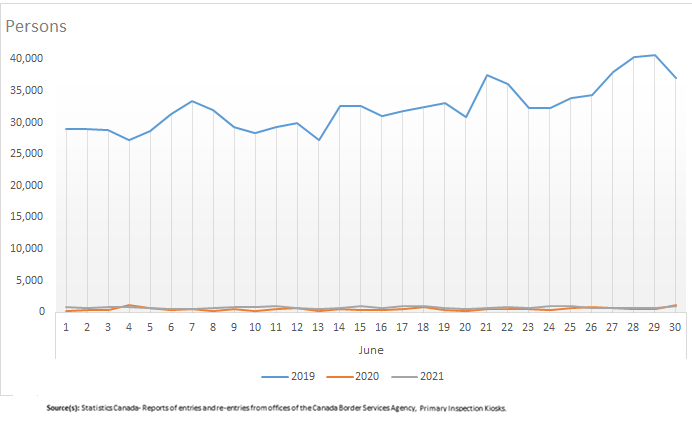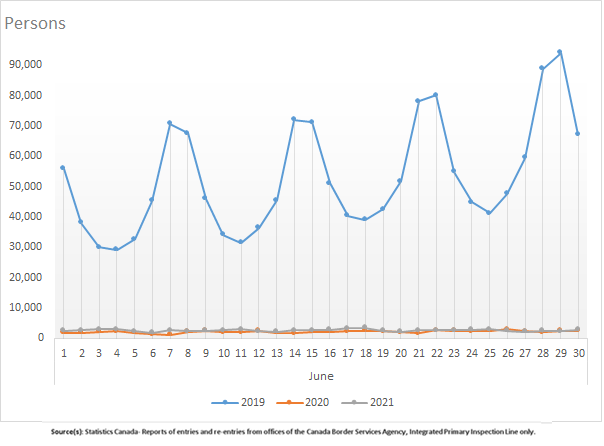Leading indicator of international arrivals to Canada, June 2021
Archived Content
Information identified as archived is provided for reference, research or recordkeeping purposes. It is not subject to the Government of Canada Web Standards and has not been altered or updated since it was archived. Please "contact us" to request a format other than those available.
Released: 2021-07-13
Highlights
In June, the number of international arrivals to Canada by land and air increased from last year, but remained well below pre-pandemic levels.
The number of non-residents arriving from abroad in Canadian airports equipped with electronic kiosks in June was almost one and a half times more compared with last year, yet still down 97.6% from June 2019.
US residents made 78,500 trips to Canada through land ports with electronic sensors in June. Although there were almost 15,000 more arrivals than in June 2020, trips were down 95.1% from June 2019.
Likewise, the number of Canadians who returned from the United States (194,600) through these same ports was almost 60,000 more than in June 2020, yet down 90.8% from the same month in 2019.
Meanwhile, the number of Canadian residents returning from abroad via these same airports was almost one and a half times more than in June 2020, but 94.3% below the same month in 2019.
This release provides a first glimpse into international arrivals to Canada in June. Complete counts will be available with June's "Travel between Canada and other countries" release.
Over one year of restrictions
The restrictions on non-essential travel across the Canada–US border were extended on June 21, 2021, for another 30 days. Additional requirements for international air travellers—like testing upon arrival with a hotel stopover—have been in force since February and remained in effect in June.
Non-resident arrivals by air
Air arrivals of non-residents from abroad—overseas countries (18,700) and the United States (4,500)—at Canadian airports equipped with Primary Inspection Kiosks (PIKs) numbered 23,200 in June, up from 15,700 in June 2020. Despite this jump, it is down 97.6% from the 970,600 arrivals during the same month in 2019.
While the PIK system was fully implemented in Toronto/Pearson Terminal 1 by June 22, 2021, these counts are excluded (see Note to readers).
Non-resident arrivals by car
In June, US residents took 78,500 trips to Canada in US-licensed automobiles through 111 land ports equipped with the automated Integrated Primary Inspection Line (IPIL) application. While this was higher than the 64,200 trips taken in June 2020, it is down 95.1% from the 1.6 million US arrivals by car in June 2019.
Canadians returning by air
The number of Canadian residents flying back from abroad in June via airports equipped with PIKs was 48,900. The June average daily volume of 1,629 returning Canadians was up from 1,400 in May 2020 and 1,131 in June 2020. For pre-pandemic comparison, there was an average of over 28,350 Canadians flying home from abroad each day in June 2019.
Again, these counts for June exclude international arrivals at Toronto/Pearson Terminal 1 (see Note to readers).
Canadians returning by car
In June, 194,600 Canadian residents returned from the United States in Canadian-licensed automobiles via the 111 IPIL ports. While this is more than the 136,400 recorded in June 2020, it is down 90.8% from the 2.1 million who drove back across the border during the same month in 2019.
Note to readers
This indicator uses administrative data from the Canada Border Services Agency on international travellers entering the country by automobile and by air.
Counts of travellers entering the country by air are from the Primary Inspection Kiosk (PIK) system and represent a subset of travellers entering Canada by air. Pre-pandemic PIK captured approximately 58% of air international arrivals as it excluded arrivals at Toronto/Pearson Terminal 1 where PIKs were not yet deployed.
PIKs were deployed to Toronto/Pearson Terminal 1 on June 22, 2021, but arrivals are excluded from June counts since they do not cover the entire month. Starting in July, Toronto/Pearson Terminal 1 arrivals will be included in the total counts of this leading indicator.
Including the PIK data from Toronto/Pearson Terminal 1 in the analysis will increase coverage to virtually all international commercial air arrivals since such flights have been restricted to four airports during the pandemic. After the pandemic, the coverage statement will be amended when a complete year of international traffic is observed for all airports.
Counts of cross-border travel by automobile through 111 land ports equipped with the automated Integrated Primary Inspection Line (IPIL) system are available by the traveller's state or province of residence, based on the licence plate of the automobile and the province of entry into Canada.
The IPIL data are a subset of Canadian and US residents entering Canada by automobile and exclude some crossings. In 2020, the 111 IPIL ports captured approximately 80% of cross-border automobile traffic between Canada and the United States.
Contact information
For more information, or to enquire about the concepts, methods or data quality of this release, contact us (toll-free 1-800-263-1136; 514-283-8300; STATCAN.infostats-infostats.STATCAN@canada.ca) or Media Relations (613-951-4636; STATCAN.mediahotline-ligneinfomedias.STATCAN@canada.ca).
- Date modified:





